Fusion Machines
In 1951, the astrophysicist Lyman Spitzer devised a way to contain a hot plasma—an ionized gas—with the hope of producing a sustained fusion reaction that could lead to electric power generation. The goal of a fusion power station has inspired generations of physicists, but the physics and engineering problems remain extraordinarily challenging.
The most promising approach is to fuse two isotopes of hydrogen—deuterium and tritium (see Plasma Power).
Deuterium is a stable isotope, but only about 0.015% of the hydrogen in water is deuterium. It is separated from water by a series of chemical reactions involving migration of deuterium from hydrogen sulfide into water and then back to hydrogen sulfide.
Tritium is an unstable isotope, with a half-life of about 13 years, and it makes up only a billionth of a percent of the hydrogen in water. Consequently, tritium must be produced separately in a breeding reaction, from neutron bombardment of lithium.
neutron + lithium-6 → tritium + helium-4
neutron + lithium-7 → tritium + helium-4 + neutron
The emitted neutron helps sustain the breeding reaction, and the two reactions together release additional energy. Although tritium is radioactive, it is one of the least dangerous of all radionuclides, according to the EPA.
As for fusion itself, the general idea is to slam the tritium and deuterium nuclei together so they react and form helium.
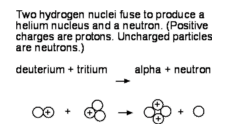
deuterium + tritium → helium-5 → helium-4 + neutron
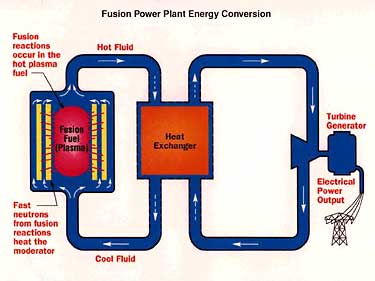
Schematic drawing of a fusion powerplant (credit: Princeton Plasma Physics Laboratory)
Most of the energy is carried off in the neutron. In a fusion power plant, the neutrons would heat a lithium blanket that, through a heat exchanger, would boil water for steam turbines in an electric power plant. In addition, reactions between the neutrons and the lithium nuclei, as described above, would breed more tritium.
The deuterium-tritium or D-T reaction is the most promising because of the forces between nuclear particles. The powerful mutual electrostatic repulsion of protons means that of all the elements, hydrogen nuclei offer the least repulsion and thereby require the lowest energy to get the reaction going. At very short distances, nuclear particles attract each other through the strong force, and the neutron in tritium adds to this attractive force, thereby promoting the fusion reaction. In this sense, a T-T reaction would seem better, but in fact it produces only 65% as much energy as D-T.
In the D-T reaction, each neutron carries off about 14 million electron volts of energy, roughly 80% of the released energy (an electron volt is the energy acquired by an electron in moving through a potential difference of one volt). These energetic neutrons constitute a considerable radiation hazard, so a fusion reactor will need a one-meter thick lithium blanket to absorb neutrons and breed more tritium. The strong neutron flux would necessitate robotic maintenance and control inside the blanket, and the radiation would make metal parts brittle. In addition, the danger of tritium leakage would require a steel container around the whole reactor.
For the deuterium and tritium nuclei to react, they must collide with very high energy. To some degree, quantum mechanics provides a way around the electrostatic repulsion of the protons, because it is possible for the two nuclei to “tunnel” through this barrier and thereby considerably reduce the necessary collision energy.
The easiest way to do D-T fusion is to accelerate deuterium nuclei into a high-velocity beam and aim it at a tritium target—tritium atoms locked in a solid. Such a machine operates as a research fusion reactor at the University of California, Berkeley. Thanks to the tunneling effect mentioned above, a 400,000 electron-volt beam of deuterium ions produces 14 million electron volt electrons. The rate of energy release is about two watts.
For a power plant, though, a sustained reaction is necessary. To keep the fusion reaction going, the deuterium and tritium must be heated sufficiently that the ions’ thermal motion will produce sufficiently energetic collisions. In this case the ions must be hot enough that they will form a plasma. As a plasma moves, its electric currents produce electromagnetic forces that act back on the plasma, so controlling and confining the plasma is a daunting challenge.
As far as safety is concerned, a fusion power plant has significant advantages over a nuclear reactor. At any time, the fusion reactor contains enough fuel for only a few minutes operation, unlike the year’s worth of fuel in a fission reactor. If the plasma container is breached, the reaction stops immediately, so there is no danger of anything like a “China syndrome” meltdown. Also, there is no problem of long-term storage of spent fuel.
Research
Since the plasma is so hot, the ions must be kept off the walls of the container. One method is to confine the plasma with magnetic fields.
Magnetic Confinement:
Charged particles spiral around magnetic field lines, and if the container closes on itself, like a torus (a donut), the plasma can circulate within the container. Various approaches have been invented for shaping the magnetic fields needed to confine such a toroidal plasma, with different advantages and disadvantages.
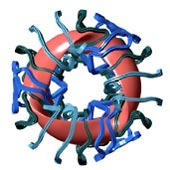
Diagram of a coil would around a torus. Note that the wires are closer together on the inside of the torus and farther apart on the outside. When the wires carry electric current, the resulting magnetic field is therefore stronger in the inner part of the torus, so the plasma ions drift towards the walls.
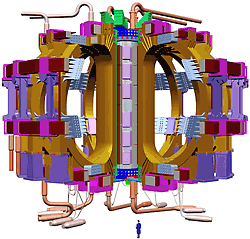
A drawing of the ITER tokamak fusion reactor. The person shown in the foreground gives the scale of this device. Also, note that the torus cross-section is uniform—quite different from the stellarator. (published with permission of ITER)
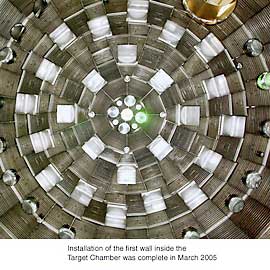
One wall of the target chamber of the National Ignition Facility (credit: National Ignition Facility)
Stellarator:
The stellarator, the first fusion machine, was designed by Lyman Spitzer in 1951. This device uses complicated coil windings, as shown in the illustration, outside the containment vessel to form the magnetic fields needed to confine the plasma. This approach avoids having to drive a large current in the plasma itself, but fabricating and positioning the magnets is a difficult challenge. The National Compact Stellarator Experiment (NCSX), a collaboration between the Oak Ridge National Laboratory (ORNL) and the Princeton Plasma Physics Laboratory (PPPL), is a proof-of-principle project to evaluate the viability of the compact stellarator. NCSX will cost about $74 million and be completed in 2007.
Tokamak:
Invented in the Soviet Union in the 1960s, this design utilizes a current driven in the plasma itself. This current generates large part of the magnetic field required for confinement. While this internal plasma current is very useful, it can also produce violent instabilities in the plasma. Decades of research have produced much progress in confinement and in the control of these instabilities. A tokamak design will be employed in ITER, an international collaboration that will “demonstrate prolonged fusion power production” and will develop and test key technologies, including the thermal lithium blanket that will breed tritium (see About section). ITER will cost about 10 billion dollars over its 20-year operating life. Construction is about to begin.
Inertial Confinement:
Inertial confinement fusion (ICF) is a method significantly different than that used in the various magnetic confinement schemes described above. ICF uses high energy beams of laser light or atomic particles to implode a small D-T fuel-filled target shell, greatly increasing the temperature and density of the fuel mixture. For example, the density of the D-T mixture can be raised to 20 times that of lead. The resulting fusion reactions cause the target to explode. Major challenges to ICF include developing high powered sources and beam timing methods that insure simultaneous target impact from dozens of individual beams. One inertial confinement project is the National Ignition Facility (NIF) at Lawrence Livermore National Laboratory (LLNL). The NIF trains 192 laser beams D-T targets about a millimeter across. NIF lasers will deliver a thousand times the electric power generated in the US, for a few billionths of a second. The NIF is now under construction.
Z Pinch:
A quite different approach to producing fusion reactions in the laboratory from either magnetic or inertial confinement methods is found in the Z Pinch. The version now operating at Sandia National Laboratories was initially devised to model nuclear explosions, and now shows promise for investigating fusion. In a Z pinch machine, a large capacitor bank is rapidly discharged through an array of fine parallel wires in a volume approximately that of a spool of thread. The huge current pulse in the wires heats the metal and vaporizes the wires into a plasma discharge. The magnetic field produced by the current in the wires exerts a radial force (use the right hand rule to visualize this) on the plasma ions, which are driven toward the center axis of the spool, producing a tremendous burst of x-rays. Recent results produced more than 80 times the power output of all the power plants on Earth, but for only a few billionths of a second—like a giant flashbulb that emits x-rays.
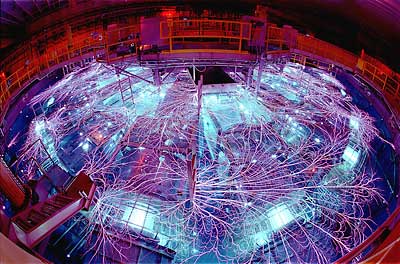
The Z Pinch machine at Sandia National Laboratory. In each shot, a large voltage is discharged through an array of tiny wires, imploding them and producing a large amount of x-ray energy. (photo credit: Sandia National Laboratory)
To compare magnetic and inertial confinement, the following table shows the temperatures, densities, and confinement times, along with temperature and density in the interior of the sun.

In fusion research and development, advances in confinement physics have paralleled associated advances in reactor engineering. Beyond the reactor, a heat exchange system employing liquid or gaseous lithium is envisioned that would power conventional steam-driven generators of electricity. Profitable energy production may require significant experience on several generations of energy producing plants.
Links
The Planetary Society
CEA/DRFC
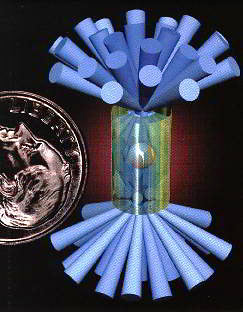
This image shows how 192 laser beams converge on the small D-T target, which is held in a metal container, in one kind of inertial confinement fusion. (credit: National Ignition Facility)
Princeton Plasma Physics Lab
Contemporary Physics Education Project (CPEP)
Coalition for Plasma Science
Plasmas International
ITER
NIF
Sandia National Laboratory














